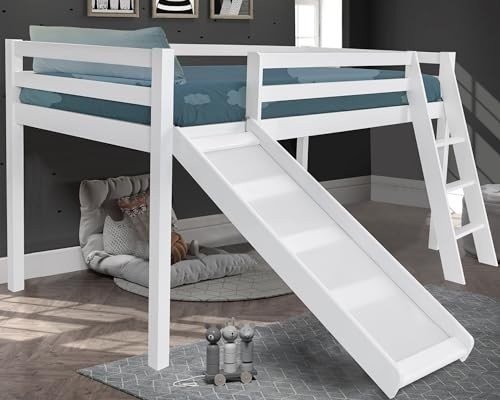Exploring Bunk Beds: A Comprehensive Guide
Bunk beds have long been a staple in kids's bed rooms, dorms, and even homes with minimal space. Not just do they provide a useful sleeping solution, but they also produce a fun and creative environment for kids and a great space-saver for adults and families. This article will check out whatever you require to know about bunk beds, from types and products to safety suggestions and buying recommendations.
Tabulation
- Types of Bunk Beds
- Standard Bunk Beds
- Loft Beds
- Triple Bunk Beds
- L-Shaped Bunk Beds
- Material Options
- Wood
- Metal
- Security Considerations
- Purchasing Guide
- FAQs
Kinds Of Bunk Beds
Bunk beds come in various styles to suit various requirements and choices. Here's a breakdown of the most typical types:
Conventional Bunk Beds
Standard bunks generally include two beds stacked vertically on top of one another. These beds are ideal for siblings sharing a space or for maximizing sleeping space in guest rooms.
Loft Beds
Loft beds stand similarly to conventional bunk beds however do not have a lower sleeping location. Instead, they frequently include a desk or seating area below, making them a great option for little rooms requiring multifunctionality.
Triple Bunk Beds
Triple bunk beds are designed for three occupants, with beds stacked in a three-tier configuration. These are less common however can be a fun option for large families or slumber parties.
L-Shaped Bunk Beds
With one bed positioned horizontally and the other vertically, L-shaped bunk beds are frequently equipped with extra features such as desks or storage drawers and can match corner areas in a room.
Comparison of Bunk Bed Types
| Bed Type | Suitable Use | Description |
|---|---|---|
| Conventional | Shared bedrooms or visitor rooms | 2 beds stacked vertically |
| Loft | Small rooms needing multi-purpose space | Upper bed with open space below |
| Triple | Big households or sleepovers | 3 beds stacked vertically |
| L-Shaped | Corner or versatile areas | A combination of vertical and horizontal beds |
Product Options
Bunk beds are manufactured from numerous materials, with wood and metal being the most common. Each product has its benefits and drawbacks.
Wood
- Toughness: Generally robust and can withstand years of usage.
- Visual Appeal: Offers a timeless look that can blend with different designs.
- Weight Capacity: Typically stronger; can support heavier weights.
- Disadvantages: May be more expensive than metal alternatives and can be vulnerable to scratches.
Metal
- Durability: Generally light-weight and simple to move however still tough.
- Modern Design: Often can be found in smooth designs, making it appealing for modern areas.
- Cost-Effective: Usually cheaper than wooden alternatives.
- Drawbacks: Can be cold to the touch in winters and might not have the exact same visual appeal for some purchasers.
Safety Considerations
When it pertains to bunk beds, safety can not be overlooked. Here are key safety pointers to keep in mind:
- Guardrails: Ensure that the leading bunk has guardrails on both sides to avoid falls.
- Tough Construction: Check for a strong construct and strong materials to hold up against weight and motion.
- Weight Limit: Adhere to the producer's weight limitation for both the upper and lower bunks.
- Ladder Design: Choose bunks with a safe, easy-to-climb ladder and prevent any sharp edges or rungs.
- Age Restrictions: Most producers advise that children under the age of six need to not oversleep the upper bunk.
Buying Guide
When shopping for bunk beds, consider the following aspects to find the best suitable for your requirements:
- Space Availability: Measure the space size and ceiling height, ensuring there is appropriate space for the leading bunk.
- Bed Size: Decide between twin, complete, or bigger sizes based on your needs and the size of the space.
- Style Preference: Consider the general design of the bedroom to discover an appropriate style.
- Relieve of Setup: Look for a bunk bed that is straightforward to assemble.
- Spending plan: Bunk beds come in various cost ranges, so identify a budget before beginning your search.
FAQs
1. What is the advised age for kids to sleep on the leading bunk?
Kids aged 6 and older are usually advised to sleep on the top bunk to minimize the danger of falls.
2. How can I make my bunk bed safer?
To boost security, make sure guardrails are properly installed and examine that the bed is put on a flat surface area. Additionally, encourage kids to utilize the ladder carefully.
3. Can I convert a bunk bed into two different beds?
Many bunk beds are created to be convertible. Check the producer's specifications for convertibility features.
4. What accessories are offered for bunk beds?
Common devices consist of bed linens, storage drawers, staircases instead of ladders, and tented canopies for an enjoyable visual appeal.
5. How do I preserve my bunk bed?
Routine look for loose screws or structural integrity can assist ensure security. Dust Bunk Beds Cheap shariah.top and clean spills without delay to keep the materials in good condition.
Bunk beds are flexible and a space-efficient solution for various living scenarios, from kids's spaces to visitor lodgings. With many designs and materials offered, prospective buyers have a wealth of choices to think about, making sure a combination of functionality and looks. By focusing on security and following the pointers outlined in this guide, people can discover the best bunk bed that fits their space and way of life, all while developing a satisfying sleeping environment.

